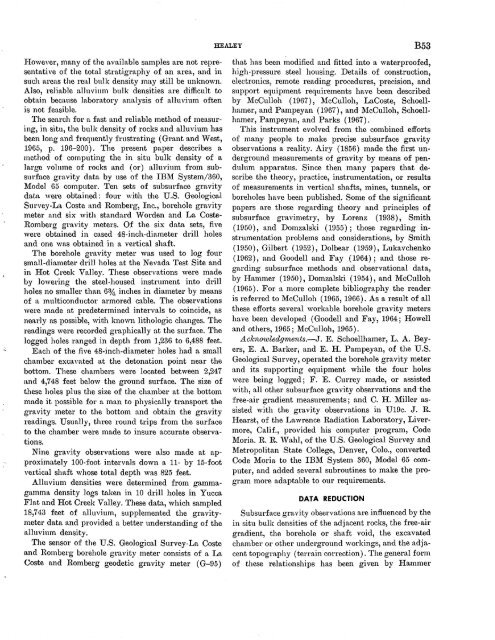RESEARCH· ·1970·
RESEARCH· ·1970·
RESEARCH· ·1970·
You also want an ePaper? Increase the reach of your titles
YUMPU automatically turns print PDFs into web optimized ePapers that Google loves.
~towever, many of the available samples are not representative<br />
o:f: the total stratigraphy of an area, and in<br />
such areas the real bulk density 1nn.y still be unknown.<br />
Also, re.liable alluvium bulk densities are difficult to<br />
obtain because laboratory ann.lysis of alluvium often<br />
is not feasible.<br />
The search for a fast n.nd reliable method of measuring,<br />
in situ, the bulk density of rocks and alluvium has<br />
been long ~tnd frequently frustrating (Grant and 'Vest,<br />
1965, p. 196-200). The present paper describes a<br />
method of computing the in situ bulk density of a<br />
1 arge volume of rocks n.nd (or) allu vi mn from subsud:ace<br />
gravity data by use of the IB1\1 System/360,<br />
1\1odel ()5 computer. Ten sets of subsurface gravity<br />
datn. were obtained: four with the U.S. Geologioo.l<br />
Survey-La Coste and Romberg, Inc., borehole gravity<br />
meter and six with stn.ndard '~r orden and La Coste<br />
Rom berg gravity meters. Of the six data sets, five<br />
were obtn.ined in cased 48-inch-diameter drill holes<br />
and one was obtained in a vertical shaft.<br />
The borehole gravity meter was used to log four<br />
small-diameter drill holes at the Nevada Test Site and<br />
in I:Iot Creek Valley. These observations were made<br />
by lowering the steel-housed instrument into drill<br />
holes no smaller than 634, inches in diameter by means<br />
of a rnulticonductor armored cable. The observations<br />
were made n.t predetermined intervn.ls to coincide, as<br />
nearly ns possible, w.itJh known lit;hologic changes. The<br />
readings were recorded graphically at the surface. The<br />
logged holes ranged in depth from 1,236 to 6,488 feet.<br />
Each of the five 48-inch-dia:rt:J.eter holes had a small<br />
chamber excn.vated n.t the detonation point near the<br />
bottom. These chambers were located between 2,247<br />
and 4,748 feet below the ground surface. The size of<br />
these holes plus the size of the chamber at the bottom<br />
mn.de it possible for a man to physically transport the<br />
gravity meter to the bottom and obtain the gravity<br />
ren.dings. Usually, three round trips from the surface<br />
to the chamber were made to insure accurate observations.<br />
Nine gravity observations were also made at approximately<br />
100-foot intervals down a 11- by 15-foot<br />
vertical slutft whose total depth was 825 feet.<br />
Alluvium densities were determined from gammagamma<br />
density logs taken in 10 drill holes in Yucca<br />
Flat and I:Iot Creek Valley. These data, which sampled<br />
18,748 feet of ttl.luvium, supplemented the gravitylneter<br />
data and provided a better understanding of the<br />
n.lluvium density.<br />
The sensor o:f the U.S. Geological Survey-La Coste<br />
and Romberg borehole gravity meter consists of a La<br />
Coste and Romberg geodetic gravity meter (G-95)<br />
HEALEY<br />
B53<br />
that has been modified and fitted into a waterproofed,<br />
high-pressure steel housing. Details of construction,<br />
electronics~ remote reading procedures, precision, and<br />
support equipment requirements have been described<br />
by l\1cCulloh ( 1967) , McCulloh, LaCoste, Schoellhamer,<br />
and Pampeyan (1967), and McCulloh, SchoellhaJner,<br />
Pampeyan, and Parks ( 1967).<br />
This instrument evolved from the combined efforts<br />
of many people to make precise subsurface gravity<br />
observations a reality. Airy (1856) made the first underground<br />
measurements of gravity by 1neans of pendulum<br />
apparatus. Since then many papers that describe<br />
the theory, practice, instrumentation, or results<br />
of 1neasurements in vertical shafts, mines, tunnels, or<br />
boreholes have been published. Some of the significant<br />
papers are those regn.rding theory and principles of<br />
subsurface gravimetry, by Lorenz (1938), Smith<br />
( 1950), and Domzalski ( 1955) ; those regarding instrumentation<br />
problems and considerations, by Smith<br />
(1950), Gilbert (1952), Dolbear (1959), Lukavchenko<br />
( 1962), and Goodell and Fay ( 1964) ; and those regarding<br />
subsurface methods and observational data,<br />
by I-Iammer ( 1950), Domzalski ( 1954), and 1\1cCulloh<br />
( 1965). For a more complete bibliography the reader<br />
is referred to 1\1cCulloh ( 1965, 1966). As a result of all<br />
these efforts several workable borehole gravity meters<br />
have been developed (Goodell and Fay, 1964; Howell<br />
and others, 1965; l\1cCulloh, 1965).<br />
Acknmoledgments.-J. E. Schoellhamer, L.A. Beyers,<br />
E. A. Barker; and E. H. Pampeyan, of the U.S.<br />
Geological Survey, operated the borehole gravity meter<br />
and its supporting equipment while the four holes<br />
were being logged; F. E. Currey made, or assisted<br />
with, all other subsurface gravity observations and· the<br />
free-air gradient measurements; and C. H. 1\1iller assisted<br />
with the gravity observations in U19c. J. R.<br />
I-Iearst, of the Lawrence Radiation Laboratory, Livermore,<br />
Calif., provided his computer program, Code<br />
1\1oria. R. R. Wahl, of the U.S. Geological Survey and<br />
1\1etropolitan State College, Denver, Colo., converted<br />
Code 1\1oria to the IBM System 360, 1\1odel 65 computer,<br />
and added several subroutines to make the program<br />
more adaptable to our requirements.<br />
DATA REDUCTION<br />
Subsurfa·ce gravity observations are influenced by the<br />
in situ bulk densities of the adjacent rocks, the free-air<br />
gradient, the borehole or shaft void, the excavated<br />
chamber or other underground workings, and the adjacent<br />
topography (terrain correction). The general form<br />
of these relationships has been given by Hammer
















